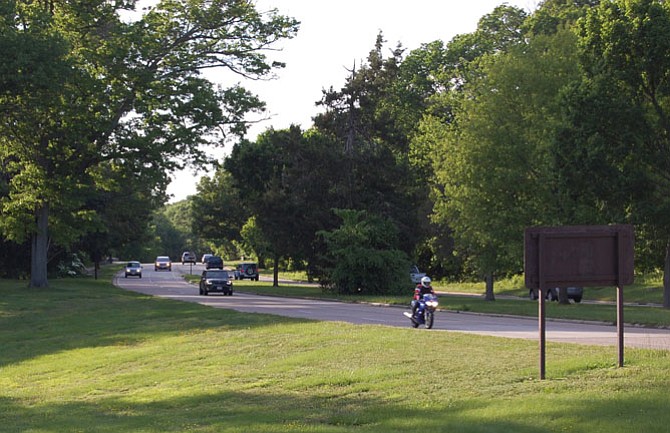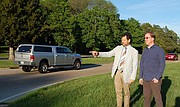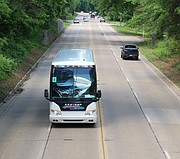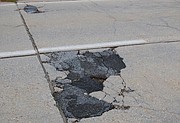Lack of Data
The office of the George Washington Memorial Parkway Superintendent is currently unable to provide overall traffic volume statistics south of Old Town to quantify individual observations about the crowded Parkway and BRAC’s impact on its traffic.
The one data point made available were car counts for three months in early 2016 on only one of two southbound lanes at Great Hunting Creek — 325,375 vehicles for April. The afternoon rush-hour volume was triple that of the morning, and thus confirming the long-standing trend of commuters leaving the District and Alexandria in the late afternoon. Once the Gazette obtains relevant statistical trends for traffic volume, a supplement to this article will be published.
Similarly, the U.S. Park Police could not readily provide accident, speeding and reckless driving statistics. Park Police Public Information Officer Sgt. Anna Rose told the Gazette that the Park Police’s centralized database, the Incident Management, Analysis and Reporting System, cannot provide useful data from before 2013. Her office is attempting to gather relevant data for a follow-on Gazette article.
“If I have my kids in the car or it’s after 6:30 a.m., then I don’t even use the GW Parkway,” said Matthew Parks, a resident in the Kirkside neighborhood in Mount Vernon. “It’s just too dangerous.”
On the other hand, Stratford Landing resident Jeff Lowery argues against overreaction — adding traffic lights and more police, for example, to better handle Parkway traffic. “Remember, the federal Bureau of Public Roads created this lovely and scenic road to illustrate the beauty of the drive between George Washington’s estate and our nation’s capital. By adding additional traffic control devices along the Parkway would be a clear affront to the original goals and plans of the BPR.”
While many Mount Vernon residents have voiced varying views on the state of the George Washington Memorial Parkway, politicians who represent them have consistently voiced concern for Parkway safety.
“There’s no question that southbound morning rush-hour traffic volumes have increased on the Parkway,” state Sen. Scott Surovell said. “It’s due to the Pentagon’s Base Realignment and Closure (BRAC) process at Fort Belvoir, 2005 - 2011. Other pressures include increased congestion on U.S. Route 1 and the widespread use of navigation apps like Waze and Google Maps.”
Del. Paul Krizek, whose district includes the southernmost part of the Parkway, echoed Surovell’s assessment. “I have always felt there were too many accidents and too much speeding on the Parkway, and it’s only gotten worse.”
Katherine Ward, chair of the Transportation Committee within the Mount Vernon Council of Citizens’ Association, seconded comments from Surovell and Krizek. “The committee has concerns with the reckless driving and speeding on the Parkway. And the situation has gotten worse since the BRAC changes at Fort Belvoir increased the number of drivers commuting to the post.”
Joe Richard, public affairs director at Fort Belvoir, provided numbers to substantiate Ward’s and Surovell’s impressions of workforce growth at the installation. “Pre-BRAC number of people working on Fort Belvoir was twenty-three thousand,” Richard said. “The current number stands at 50,000, a gain of 27,000 civilians, contractors and military.”
On the other hand, changing visitor totals at the Mount Vernon Estate don’t appear to be a factor in Parkway traffic volume. Nine hundred thousand people visited in 1941, 1,250,00 in the mid-1970s, and 1,075,109 in 2016.
The dialogue on Parkway traffic south of the Beltway has gained urgency in the past year among citizens and elected officials because of several Parkway accidents. The most significant occurred on June 14, 2016, in which a head-on collision between a car and small tourist bus near Stratford Lane left one dead and 15 injured.
More recently, another bus accident closed the Parkway near Waynewood Boulevard on April 3 of this year. Three weeks later, on April 27, a two-car crash occurred during the morning rush hour at the Parkway’s Morningside Lane intersection. A helicopter ambulance took one critically injured occupant to a nearby hospital.
The April 27 accident caught the attention of Waynewood resident David Anderson, who commutes daily on the Parkway. “I’ve always considered Morningside to be the most dangerous part of the Parkway,” Anderson said. “Traffic flows at high speed southbound from the stone bridge and sight lines of those waiting on Morningside to turn north are obscured. Because of this, I’ve always believed that left turns should be prohibited at that intersection.”
Soon after the Morningside accident, Anderson posted a poll on Nextdoor.com, an online community list serve, which asked residents if authorities should prohibit northbound turns from Morningside onto the Parkway. More than 60 percent of 630 responses favored such a restriction. “In addition,” Anderson said, “the survey provoked a pretty vigorous debate among those who posted their views on the Parkway’s traffic conditions.” Nearly 160 residents commented on Anderson’s posting.
Unbeknownst to Anderson and his respondents, U.S. Rep. Don Beyer had asked the National Park Service and the Federal Highway Administration in 2015 to examine the Parkway - Morningside Lane intersection. The study, conducted in December 2015, determined the 85th percentile of vehicular speed of vehicles passing the intersection was 52 mph. Moreover, historic crash data revealed 30 accidents at or near the intersection occurred 2006 - 2012. That data made the examiners label the Morningside intersection a GWMP “hot spot.”
Despite concern for traffic volume, accidents and reckless driving south of Old Town, two more matters, both equally dangerous, have garnered less attention — Parkway lane widths and road surface deterioration. The inner lane in each direction is only nine feet wide, and the outer, 11 feet. In contrast, Virginia’s Department of Transportation currently requires a principal rural arterial with design speeds of 45 - 50 mph to have lanes at least 12 feet wide. Curbed urban arterials that ban trucks can have 11-foot lanes at 45 mph, but need 12-foot lanes at 50 mph.
The large tour buses serving Mount Vernon visitors are 102” wide, and they routinely travel in the center lane that is only 108” wide. They have to travel in that lane to pass under the Alexandria Avenue stone bridge, but when queried, two drivers parked at Mount Vernon said they prefer staying in the lane for the entire route.
The Parkway road surface has suffered from a plague of potholes, largely caused by wintertime freeze-thaw cycles, in recent years from Mount Vernon north to the American Legion Bridge. The only thing Parkway maintenance crews have done lately is pack the potholes with asphalt soon after they appear, but not before drivers suffer flat tires and suspension damage.
The ongoing debate about how to address the Parkway’s safety has historical precedents. Similar problems and potential solutions have made news in the past, and those situations and actions give context to today’s traffic issues.
PARKWAY GROWTH, GOOD AND BAD
President and Mrs. Herbert Hoover celebrated the informal opening of a new avenue to Mount Vernon, George Washington’s iconic estate, on Jan. 16, 1932. Their limousine led a caravan of 12 vehicles across the newly opened Memorial Bridge and then on to Mount Vernon. Later in the year, on Nov. 15, 1932, federal officials formally dedicated the George Washington Memorial Parkway.
Throughout the Great Depression and World War II, the Parkway remained a scenic drive through field and forest, offering river views. But post-WW II federal government expansion in the District and corresponding suburban growth in Northern Virginia began to force changes in traffic patterns on the Parkway. Also, the government extended the road north in 1959 to Langley, initially to serve the new CIA headquarters there, and then further lengthened it northward to the new Capital Beltway in the 1960s.
Fairfax County’s Board of Supervisors, according to the Washington Post, became concerned about Parkway safety in 1962, especially the efficacy of roadside guardrails north of the Key Bridge, and threatened to install signs at Parkway entrances that read, “Beware, you are now leaving the protection of the Virginia State Highway Department.”
The Post reported in 1971 that traffic volume on the Parkway near the Key Bridge had doubled from 1959 to 1971, presumably because of road’s increased length.
In August 1971, Parkway Superintendent Dave Richie acknowledged Parkway traffic problems, noting that drivers were far less interested in the scenery that getting to work on time. “We can’t forestall the Parkway becoming a commuter thoroughfare,” he told reporters. “Too many people depend on it. We have to make it safe for commuters and still try to make it aesthetically pleasing.”
Richie added that drivers were ignoring the 45 mph speed limit, and most traveled at 60 - 65 mph. According to the Post, he said there were not enough park police officers to enforce the speed limit. The newspaper also reported that the Parkway’s high-speed traffic and congestion made it one of three most dangerous roads in the national park system in 1970, with eight fatalities and 123 injury accidents that year.
During the period 1984 - 1988, the National Park Service rebuilt multiple sections of the concrete roadway south of Belle Haven, and the repairs challenged commuters daily. Now, 30 years later, the newer slabs of concrete seem to be faring as poorly as the original road surface. The original segments are a light tan-orange color with more exposed aggregate.
In August 1999, GW Parkway Superintendent Audrey Calhoun announced the Park Service planned to commence a six-month trial of radar-equipped speed cameras in two locations — at Reagan National Airport and near the entrance to CIA headquarters. “The speed on the Parkway and all the aggressive driving,” she told reporters, “it’s been a problem for years.” She said the camera program’s impetus came from a 1996 accident that killed three people during a high-speed race between two cars.
The radar/camera device on the northbound lanes just north of the airport determined that 50 percent of the 24,000 vehicles that passed the equipment daily exceeded the 40-mph speed limit by at least 10 mph. The Park Police did not issue any tickets during the trial.
Not everyone was pleased with the speed cameras, according to the Post. One opponent, House Majority Leader Dick Armey (R-Texas), wrote Interior Secretary Gale Norton in May 2001. He asked her to ban the devices on the George Washington Memorial Parkway, calling them “a step toward a Big Brother surveillance state.” Calhoun told the Gazette in 2005 that the Commonwealth of Virginia eventually had prohibited speed camera use on the Parkway.
During the six-month period February - July 2005, the Gazette learned that the Park Police had recorded 51 accidents on the Parkway between Reagan National and Mount Vernon, including two fatalities; that’s about one crash every three-and-a-half days. When asked, Calhoun repeated an assessment of Parkway traffic shared by most local residents: “The Park Police focus on speeding and write a lot of tickets, but when people don’t see them, they think they can speed. The reality is that we have too much traffic and not enough officers.”
More recently, many Mount Vernon residents have offered the same story from the times they had driven in the Parkway’s right lane: “Other cars passed me as if I were standing still! They must have been doing 55.”
POSSIBLE SOLUTIONS
The challenges arising from the Parkway’s narrow lanes will be unmet without wholesale reconstruction, an undertaking hindered by the Parkway’s status as an historic landmark. Similarly, according to Aaron LaRocca, the chief of staff in the Office of the GWMP Superintendent, pot-hole patching operations are limited not only because of the Parkway’s place in history, but also the Park Service’s shortage of repair funds.
“While the Parkway is an important commuter roadway and serves as an integral part of the region’s transportation system, it is also a park,” LaRocca said. “It is listed as a historic property on the National Register of Historic Places as being significant for a number of reasons, including landscape and roadway design. Because the entire GWMP is included on the Register, we cannot manage the roadway in the same way states manage roads.”
On the other hand, programs to calm Parkway traffic seem within reach, at least in the minds of local residents. Cameron Curtis of Mason Hill offered her views: “Increased police presence would help, and the Park Police should randomly station a car in the turn-off between Tulane Drive and Morningside Lane.” But Curtis added that some of the onus has to be on the drivers. “If everyone would slow down and pay closer attention, accidents would happen less frequently.”
Katherine Ward, Transportation Committee chair at the Mount Vernon Council of Citizens’ Association, agreed: “The problems on the Parkway are about people. People are rude, discourteous and in a hurry. This is a scenic roadway, not part of the Beltway.”
Waynewood resident Tony Mazzoccoli suggests several traffic management options. “Assuming the Parkway will not be altered or improved to accommodate current traffic patterns, the simplest solutions could be the following: restrict left hand turns onto the Parkway at rush hour at key intersections and limit access to the Parkway at some intersections at rush hour.” Mazzoccoli also urged protection for pedestrians and cyclists crossing the Parkway. Several others, including Surovell, have recognized that issue, especially people walking across the roadway to catch the northbound 11Y Metrobus in the morning.
Steve Chaconas, who lives in Stratford Landing, thinks speed cameras “are a good idea and a good start,” but scoffs at turn limits at some intersections: “If they can’t enforce the speed limit, how will they enforce restricted turns?”
Beyer, in a statement provided to the Gazette, lamented the state of the Parkway today. “Traffic volume and commuter use of the George Washington Parkway is far beyond what was originally envisioned for this picturesque road.” Additionally, he promised continuing attention to the matter. “Together with other elected officials, I have asked for updated statistics for this roadway and will continue to pursue solutions with the National Park Service.”
U.S. Sen. Tim Kaine is also concerned and offered this statement: “We’ve heard from both residents and local officials in light of some recent safety incidents on the Parkway. My office has submitted a request for traffic data on the Parkway in order to get more information about safety trends and potential ways to reduce the risk in these areas.”
Surovell offered several possible fixes. “I support an increased police presence during rush hour and speed cameras,” he said. “Left turn restrictions should be studied, but I am concerned about the impact restrictions would have on remaining local roads and Fort Hunt Road congestion.”
Krizek also addressed the speeding matter: “There is only one Park Police officer on duty at any one time on the Parkway between the north end of Reagan National Airport and the Mount Vernon Estate. I have insisted the Park Police get more policemen on the Parkway.”
Krizek also said he would support a multifaceted traffic management program beyond visible police — perhaps cameras, rush-hour restrictions and solutions to dangerous pedestrian crossings.
Ward seconded the need for increasing police presence. “The committee met with Park Police officials last year,” Ward said, “and asked for more police patrols on the Parkway, but they said they don’t have enough officers. We asked those officials to approach the Fairfax County Police and ask for help.”
The Park Police’s Sgt. Rose, when asked about potential traffic-calming measures such as speed cameras and turn restrictions during rush hours, offered the following statement: “The USPP maintains a patrol presence along the George Washington Memorial Parkway and utilizes several methods to deter speeding and other dangerous driving activity including radar and lasers.” Rose then offered an explanation for traffic-calming challenges that is virtually identical to LaRocca’s statement regarding the deterioration of the Parkway’s road surface: “Because this is a historic roadway and a park, and is listed on the Register for Historic Places, we cannot manage the roadway in the same way states manage roads.”
Hollin Hills resident Baird Smith is a retired architect who has worked extensively on historic site renovation, both as a NPS employee and in private practice. He has a proposed solution to the unsafe Parkway conditions. “The NPS should excess its parkways to state governments to be incorporated as state highways and parks for the following reasons:
NPS parkways are a second priority for annual funding because they are not within the core mission;
Parkway staffs are ill-suited to highway management, maintenance and design;
Heavy use of parkway roads requires disproportionately high maintenance funding;
The Park Police have difficulty in providing for public safety because of the wholly linear nature of the coverage zone.”
As proven by traffic concerns that have erupted several times in the past 50 years, the future may be even worse than now. Krizek sees troubling developments on the horizon: “The Parkway problems will get worse in 2023 when a planned widening of Route 1 begins between Jeff Todd Way and Napper Road in Gum Springs. During construction, drivers will bail out onto the Parkway, a big-time concern.”
Given that prediction, Mason Hill resident Cameron Curtis suggested: “Fairfax County, the Commonwealth and Parkway management need to get together with residents and talk about traffic in the greater Route 1 corridor. We have to work together on solutions to adapt to the growing commuter needs on Route 1, Fort Hunt Road and the GW Parkway. Fixing one road won’t solve the problem.”




